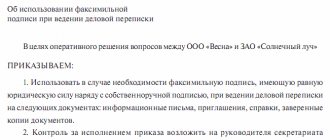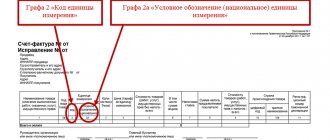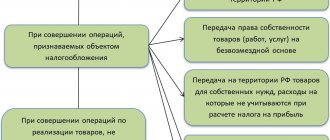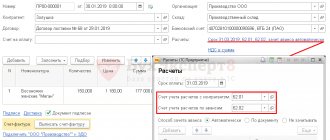The primary document confirms various events in the business: the sale or purchase of goods, the provision of services to clients, the payment of salaries to employees, and others.
Depending on the event, the list of documents to be completed varies. Let's consider a common situation - a transaction involving the sale of goods and the provision of services. It is customary that the documents are prepared by the supplier or contractor.
In video format, we talk about the execution of transactions in the course of a young individual entrepreneur. The course contains 11 free lessons, tests and practice; in addition to documents, it will help you understand taxes, using online cash registers, choosing a bank and audits.
Documents for a transaction with a client:
- The contract is the beginning of the transaction. In it, you and the client determine the terms of cooperation: what, for what price and in what time frame you do. If the client is a regular one, you can draw up one agreement for several transactions.
- The invoice contains the amount to be paid, a list of goods and services and the bank details of the seller. This is an optional document, but is usually used for convenience.
- A cash receipt, sales receipt or strict reporting form confirms payment. Give them to the client who pays in cash or by card. When paying by bank transfer, payment is confirmed by the payment order.
- Invoice is a document that the supplier issues to the buyer when shipping goods.
- An act of provision of services or completed work is a document that the customer and the contractor sign based on the results of the provision of services or completion of work.
- Invoice - usually issued by individual entrepreneurs and LLCs using the general taxation system, because they work with VAT. In rare cases, invoices are issued using the simplified tax system, UTII and patent - read more about this in the article.
- UPD replaces the act/invoice + invoice.
Submit reports in three clicks
Elba will take over the accounting.
The service will prepare reports and send them via the Internet. It will calculate taxes, reduce it by contributions - and you will receive ready-made payments for payment. Try 30 days free Gift for new entrepreneurs The promotion is valid for individual entrepreneurs under 3 months old
Invoice and invoice - what's the difference?
Invoice and invoice - what is the difference between them and what causes it? Let's look at the features of these two documents and compare them.
Invoice: what are the characteristic differences of this document?
How does an invoice differ from other documents?
What are the similarities and differences between an invoice and an invoice?
Results
Invoice: what are the characteristic differences of this document?
To understand how an invoice differs from an invoice, you need to have a clear understanding of exactly what characteristics are inherent in each of the documents in question. We will begin this review with an invoice - a document, all aspects of the use of which are regulated by law:
The invoice serves as the basis for deducting VAT. The absence of this document makes it impossible to exercise this right.
The preparers of the invoice are:
- sellers of goods (works, services) carrying out transactions subject to VAT;
- tax agents.
There are three types of this document, the use of each of which is determined by the situation requiring its execution:
- for sale - it is compiled when selling goods (performing work, providing services) or transferring property rights;
- for advance payment - it is applied when the seller receives an advance payment from the buyer;
- adjustment - is compiled when there are changes in the cost or volume of shipped goods.
Each type has a set of required details and design features. But there are only two approved forms of forms:
- main (regular) - documents are generated on it for sales and when receiving advances, taking into account the presence of special requirements for preparation valid for these two situations;
- adjustment - it is used if changes need to be made to an already issued original document regarding changes in price or quantity shipped.
Prices and values in the invoice may be reflected in foreign currency if this meets the conditions of the transaction.
The document can be drawn up either on paper or electronically. In the latter case, it must be signed with an enhanced qualified electronic signature of an authorized person.
How does an invoice differ from other documents?
Unlike an invoice, the application rules for an invoice for payment are not established by law. It also does not have a set form. However, this does not detract from the importance of such a document for the relationship between the payer and the recipient of funds.
Typically, an invoice arises in situations where a condition for delivery (regardless of whether a written agreement is drawn up between the parties) is the availability of payment in advance. The seller draws up such a document, reflecting in it:
- your details necessary to receive payment;
- data of the buyer (payer), allowing him to be identified when the purchased item is transferred to him;
- information about the subject of the transaction indicating information that makes it possible to clearly understand how its final value was formed;
- number and date of the agreement under which payment is made (if such a document exists).
Each invoice is assigned a serial number, accompanied by the date the document was created.
Having an account provides:
- specification of the volume of each next advance payment in the presence of contractual relations;
- provision of comprehensive information about the seller’s details, taking into account the fact that in terms of the current account they may differ from those specified in the contract;
- the ability to refer to a specific document in the purpose of payment when paying and in the power of attorney to receive the purchased item.
The invoice may additionally reflect:
- deadlines for making payments;
- the exchange rate in relation to which the ruble amount was calculated;
- conditions for shipment of paid goods.
Thus, the invoice turns out to be a document either containing information that supplements the agreement concluded between the parties, or the only one that provides all the necessary information regarding the transaction being made.
What are the similarities and differences between an invoice and an invoice?
Already from the above descriptions of an invoice and an invoice, the difference between them becomes quite clear. However, here are the main differences:
| Criterion | Invoice | Check |
| Mandatory registration | Mandatory when carrying out transactions subject to VAT | Not required |
| Purpose of registration | Using VAT deduction | Issuance to the payer of a document with the recipient’s details and payment amount |
| and shape | Both content and form are legally defined | There is no legal regulation. dictated by purpose. Content determines form |
| Types of documents processed | There are three different types, but two forms of forms are used to complete them | The form is developed by the person issuing the invoice. For him, its form is usually the only one, but as a rule, it differs from those used by others |
| Significance | Serves as a mandatory justification for conducting accounting transactions related to VAT | Does not create accounting transactions, but can specify the conditions set out in the agreement |
However, these two documents also have common features. Both of them:
- are issued by the seller;
- contain details of the seller and buyer;
- reflect the process of forming the final cost of what is being sold, including VAT;
- may be written in currency;
- can be in either paper or electronic form.
The presence of common features of this kind makes it possible to simplify the process of creating shipping documents in accounting systems. This is achieved thanks to the possibility of generating a delivery note (act) and an invoice based on the invoice issued to the buyer.
Results
The difference between an invoice and an invoice is very significant and is determined by the presence of different:
- requirements for mandatory registration;
- purposes of creation and use;
- content and form.
At the same time, there are also common features that arise due to the presence of these documents:
- one creator;
- a number of general information that is key for both the invoice and the invoice.
The presence of common features allows, in the conditions of automated accounting, to create shipping documents based on the data reflected in the invoice issued to the buyer.
Subscribe to our accounting channel Yandex.Zen
Subscribe
Source: https://nalog-nalog.ru/nds/schetfaktura/schet-faktura-i-schet-v-chem-raznica/
Agreement
Describes the rights and obligations of the parties to the transaction. Typically, a contract contains the following sections:
- Subject of the agreement: what is the result of the transaction.
- Contract amount and payment procedure: when and how much to pay.
- Rights and obligations of the parties: how the work happens.
- Responsibility of the parties: what happens if you or your partner violate the deadlines.
- The procedure for changing and terminating a contract: how to terminate a contract or accept additional agreements to it.
- Details of the parties: what are your and your partner’s current accounts, INN, OGRN and addresses.
The agreement is usually drawn up in 2 copies and contains the signatures of each party.
If you use a standard contract form with clients and replace the necessary details in Word or Excel, use templates in Elba. Upload your agreement template, and Elba will automatically fill in the details of the counterparty from the directory.
For some transactions, a written contract is not necessary at all. For example, a purchase and sale agreement is considered concluded from the moment a cash receipt, sales receipt or other document is issued to the buyer, which confirms the fact of payment. This does not mean that during a retail purchase and sale it is impossible to conclude an agreement in writing - the law does not prohibit this.
Article: How people cheat in contracts
Templates of common agreements:
Service agreement template
Contract agreement template
Supply agreement template
What is the difference between an invoice and an invoice?
Typically, the invoice is issued by an accountant.
There must be a basis for this - a purchase and sale agreement or an agreement for the provision of any services. This document indicates the specific amount that the payer undertakes to transfer to a current account or pay at the cash desk of the supplier organization for a service performed or for a specific product. If the contract stipulates a reusable service (once a month for a year or once a quarter), then this invoice can be issued once a month, once a quarter, or for the whole year at once. As a rule, the invoice is not a strict reporting form and is not recorded in the sales book. Having an account is necessary mainly for prepayment.
Check
An optional document in which the seller indicates the price, quantity of goods and details for transferring payment.
You can come up with an invoice form for payment yourself or find a ready-made one on the Internet. An invoice can replace a contract if all essential terms of the transaction are included in it.
Invoice template
Elba has a ready-made invoice template. Select the counterparty, indicate the goods or services, their quantity, and the document is ready.
How does an invoice differ from other documents?
Unlike an invoice, the application rules for an invoice for payment are not established by law. It also does not have a set form. However, this does not detract from the importance of such a document for the relationship between the payer and the recipient of funds.
Typically, an invoice arises in situations where a condition for delivery (regardless of whether a written agreement is drawn up between the parties) is the availability of payment in advance. The seller draws up such a document, reflecting in it:
- your details necessary to receive payment;
- data of the buyer (payer), allowing him to be identified when the purchased item is transferred to him;
- information about the subject of the transaction indicating information that makes it possible to clearly understand how its final value was formed;
- number and date of the agreement under which payment is made (if such a document exists).
Each invoice is assigned a serial number, accompanied by the date the document was created.
Having an account provides:
- specification of the volume of each next advance payment in the presence of contractual relations;
- provision of comprehensive information about the seller’s details, taking into account the fact that in terms of the current account they may differ from those specified in the contract;
- the ability to refer to a specific document in the purpose of payment when paying and in the power of attorney to receive the purchased item.
The invoice may additionally reflect:
- deadlines for making payments;
- the exchange rate in relation to which the ruble amount was calculated;
- conditions for shipment of paid goods.
Thus, the invoice turns out to be a document either containing information that supplements the agreement concluded between the parties, or the only one that provides all the necessary information regarding the transaction being made.
Payment documents
Confirms payment for goods or services. This can be a payment order, payment request or cashier's check.
A cash receipt is issued using an online cash register. It is required to be used by everyone who accepts payments in cash and by bank cards. Exceptions are listed in paragraph 2 of Article 2 of Law 54-FZ. Under the patent, only some entrepreneurs must use the cash register, while the rest are exempt. Look at the list in the article, where you will also find information about the deferment until 2021 for individual entrepreneurs without employees and complete instructions for switching to online cash registers.
Article about online cash registers
The payment order remains with the entrepreneur when he transfers money via Internet banking. This document confirms the transfer of funds using certain details.
A sales receipt is an optional document that is issued at the buyer’s request. The buyer needs a document to confirm that he not only spent a certain amount of money, but also bought certain goods - for example, on behalf of his manager. The form of the sales receipt has not been established, so you can develop your own with the required details: name of the document, number, date, name of the LLC or full name of the individual entrepreneur, INN, goods and services, amount of payment and signature with transcript and position.
Tax instrument
In order to confirm that the goods have actually been shipped or the service has been provided, another document called an invoice is issued. It, indicating the cost of goods shipped or services provided, or work performed, is sent to their buyer after he has accepted the purchase in the prescribed manner.
In the Russian Federation, the concept of such an account and the regime for its application are established by tax legislation. It specifies that the invoice is intended solely for VAT accounting. It has been established that it must be a document of a strictly defined sample and is drawn up by an economic entity that is obliged to pay tax to the budget. It is this invoice that serves as the documentary basis according to which the buyer accepts for deduction the amount of this tax presented by the seller. Russian legislation allows for the possibility of issuing an electronic invoice using a special procedure.
Regardless of the type of account, it must contain:
- Name and details of the supplier and purchaser.
- List of shipped goods, services (works).
- Prices and cost of goods (services).
- Tax rate and VAT amount.
- Other necessary information.
The seller is obliged to issue such an invoice to the buyer paying VAT. After all, this document provides the basis for the corresponding tax deduction. Such a document itself cannot be used as confirmation of the transfer of goods from the seller to the buyer. It can only be confirmed by a properly issued invoice. Confirmation of accepted services, works or property rights is the corresponding act of acceptance and transfer.
The seller and buyer must enter information about issued and accepted invoices in special journals. Issued documents are recorded in the sales book, accepted documents are recorded in the purchase book. The seller has the right not to issue such an invoice to a counterparty who is not a VAT payer. The parties must first agree on this in writing. When preparing primary documents with such a partner, the seller must indicate the amount of tax in them, and the buyer does this when filling out a payment order. Also, such invoices are not issued in cases of sale of goods or services to citizens.
Business entities that are exempt from VAT issue invoices when they are tax agents or intermediaries. In such cases, they submit tax returns and pay the amount to the budget themselves. The tax amount is not highlighted in the invoices they issue. The documents must be marked “Without VAT”. To avoid mistakes when accounting for expenses and income, another document with the allocated amount of this tax can be used. For example, a bank statement or a sales receipt.
Consignment note (N TORG-12)
Registers the sale of goods to another individual entrepreneur or LLC. It is usually not used for working with individuals.
The invoice is issued in two copies: the first remains with the supplier and records the shipment of goods, and the second is transferred to the buyer and is needed by him to accept the goods.
Usually the invoice is drawn up according to the standard TORG-12 form. But you can use your own template.
Invoice template
Article: consignment note TORG‑12
In Elba you can create an invoice based on an invoice.
Normative base
An invoice is issued for a preliminary agreement on the transfer of funds specified in it for a service or product. The invoice is issued both with and without an agreement. Sent to the buyer via email or delivered in person.
currently no
, and the previous form in form No. 868 is outdated. Therefore, enterprises independently develop them.
The invoice must contain the following details
:
- Information about the supplier's bank account to which payment should be received.
- Name of the enterprise or individual entrepreneur carrying out the supply and legal address.
- Date and account number.
- Basic information about the agreement that served as the basis for issuing the invoice.
- The name of the services provided or the goods supplied, the cost of the commodity unit and the total amount.
- VAT amount.
- Signatures of responsible parties.
The supplier issues two invoices for payment
:
- For the buyer for payment purposes.
- For the accounting department of your own organization.
The account can be prepared by either an accountant or another authorized person appointed by management. It is stamped and signed by the chief accountant and manager.
The archiving period for this document issued by the buyer is five years
.
Invoice is an important document for the buyer
(paying VAT), providing the opportunity to receive a deduction for this tax. Invoice:
- is not a primary document;
- does not confirm the fact of transfer of goods;
- does not confirm the provision of services.
The above follows from the Federal Law “On Accounting”, the Tax Code of the Russian Federation.
The rules for filling out and issuing an invoice are prescribed in Article 169 of the Tax Code of the Russian Federation.
The sales invoice must contain the following details
:
- date and account number of the document;
- details of both parties involved in the transaction: TIN, location, name;
- point of delivery or shipment of goods;
- a unique feature of a government contract or agreement (if any);
- the name of the services provided or goods supplied, the cost of the commodity unit and the total amount;
- VAT amount;
- No. of cargo customs declaration and country of origin;
- code of the type of product according to the unified Commodity Nomenclature of the Eurasian Economic Union;
- signatures of the responsible parties.
Invoice
This document is required to be issued only by organizations and entrepreneurs that are VAT payers - mainly those who work on the general taxation system.
Organizations and individual entrepreneurs on the simplified tax system, UTII and patent usually do not pay VAT and therefore are not required to issue invoices. There are a few exceptions, which we covered in a separate article.
The invoice is issued in duplicate and signed by the supplier of the product or service. One copy is given to the buyer, the other remains with the seller. An invoice must be issued no later than 5 days after shipment of goods or provision of services.
An invoice is the basis for deducting VAT, so all organizations treat it with special trepidation.
In order not to study the form and rules for issuing an invoice, use Elba.
What is the difference between an invoice and an invoice?
The first thing that an official preparing financial statements should understand is the difference between an invoice and an invoice.
It is precisely because of a lack of understanding of the differences that many inexperienced workers make a large number of various errors associated with the generation of reports of this type.
First of all, the following questions should be clarified:
- availability of correspondences;
- difference with the delivery note;
- ratio with ;
- difference between and SF.
Availability of matches
Understanding how an accounting account and an invoice are similar is not so difficult. The most important matches are:
- information presentation format;
- data indicated in the documents.
All information in both the invoice and the regular accounting account is presented in tabular form. A typical account contains only five columns:
- Contents of operation;
- document;
- correspondent account numbers - debit, credit.
All information is presented as briefly as possible. The invoice, in turn, is also partially represented by a table. But it has a slightly larger number of columns - about 11.
At the same time, there is a fairly extensive list of various additional information, including exact details, addresses, tax identification number and checkpoint.
That is why it is somewhat easier to prepare a regular accounting account - all the information is reflected in it more concisely.
Difference with delivery note
It is quite difficult for many to understand the difference between an invoice and a delivery note. And this is logical, since in fact these two documents look completely identical.
The only difference is the presence of a special seal on the . Otherwise, this document and the invoice are completely identical documents.
But their main difference lies not in content, but in purpose:
Moreover, the same document cannot perform two functions at the same time. A tax deduction cannot be obtained on the basis of a bill of lading, and an invoice does not confirm the existence of ownership rights to any goods or other property. That is why they should not be confused in any way.
Correlation with invoice
In addition to the delivery note, there is another document similar in its purpose and format to an invoice. It represents an invoice.
This term has two different concepts:
In the first case, according to the registration rules, the invoice must also contain the same information as the attached invoice.
That is why we can say that the differences between these documents are minimal. In the second case, the invoice is a commercial invoice, and therefore has a minimum number of similarities with an invoice.
A commercial invoice includes detailed demands from the seller to the buyer to pay the amount indicated in the documentation. But at the same time, the invoice and invoice contain identical information (invoice amount, price per unit of goods, etc.).
The difference between the act and the Federation Council
Many contractors performing any work or providing services create two documents at the same time:
- invoice.
They have some similarities with each other. In particular, this applies to the designation of some data - cost, provided, as well as details.
But that's where the similarities end. Since the SF is a document of strict reporting, and the certificate of work performed does not have a specific form and can be prepared by the contractor at its discretion.
In addition, it will not be possible to receive a deduction based on this document or any other benefits based on it.
It is necessary to study in as much detail as possible all the most important points regarding the procedure for generating an invoice, as well as an accounting account. This will allow you to avoid various kinds of misunderstandings and mistakes.
This is especially true for the SF, since it entitles many payers of value added tax to special benefits.
To make payments for services rendered or goods supplied between enterprises or with individual entrepreneurs, accompanying documentation is drawn up
. The seller issues an invoice to the buyer for payment. When unloading the goods - an invoice (provided that the seller pays value added tax).
The invoice for payment is the primary document
, which is billed to the buyer by the supplier of the service or product. It has the same meaning in relation to all participants in the transaction. The function of the account is a preliminary agreement on the transfer of funds specified in it. It can be registered by an individual entrepreneur or an enterprise.
Based on the invoice issued by the seller to the payer, the latter issues a payment order. For the supplier, and subsequently the recipient of funds, the role of the document
is:
- in entering information about the point of receipt;
- in maintaining information about the name of a product or service, quantity and monetary value for a certain amount of time.
An account is not a mandatory accountable accounting document, since details and name may also contain other documents.
An invoice is a standard payment document issued to the buyer by the seller for services performed or goods delivered. This document is required in order to present the amount of tax on the difference between the cost of goods and services produced by the company to the tax authorities in order to receive a deduction.
.
The function of an invoice is to prove the rights of a party
paying value added tax (VAT) and receiving a deduction for it.
If an error is detected in the form on the part of the taxpayer, VAT is not refundable
.
When to issue invoices
The invoice must be issued:
- organizations that have operations subject to VAT (clause 3 of Article 169 of the Tax Code of the Russian Federation). This rule also applies to those who have received tax exemption under Article 145 of the Tax Code of the Russian Federation (clause 5 of Article 168 of the Tax Code of the Russian Federation);
- intermediary organizations that sell goods (work, services) on their own behalf under a commission agreement or agency agreement, if the principal or principal applies the general taxation system (clause 1 of article 169 of the Tax Code of the Russian Federation, clause 20 of section II of appendix 5 to the Government Decree RF dated December 26, 2011 No. 1137);
- organizations that received an advance (partial payment) from the buyer or customer towards the upcoming sale (clauses 1 and 3 of Article 168 of the Tax Code of the Russian Federation).








